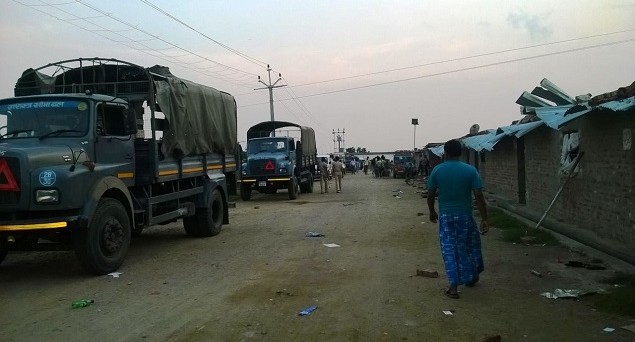By Waquar Hasan,
New Delhi / Patna, 22 Aug 2015: In comparison to Uttar Pradesh, Maharashtra or Karnataka, the society of Bihar is not as much polarized. However, the state has witnessed a surge in communal violence since BJP of Prime Minister Narendra Modi and JDU of Chief Minister Nitish Kumar parted ways two years ago. As Bihar is not Uttar Pradesh, will BJP be able to play its tested saffron cards or the upcoming state assembly elections will be fought amidst sporadic communal clashes?
According to an investigative report of The Indian Express, after the split of BJP and Janata Dal (United), there has been a steep rise in communal incidents. From June 2013, when the two parties parted ways, till July this year, 667 communal incidents have taken place in the state. But in the three and half years that the BJP and JD(U) were together in power, there were 226 communal incidents across the state. The report also says that most of the 667 communal incidents have taken place in 10 districts which are represented by BJP in legislative bodies.
Is the surge in communal violence a failure of Nitish government? Or is his rival party trying to create disturbances deliberately to damage his government?
Mahendra Kumar, a social activist in Patna, sees BJP’s hand behind rise in communal violence in the state.
“It is wrong to say that there is rise in communal riots in Bihar. But indeed there has been an increase in communal tension. And it is not the failure of the administration but it is because of those who do politics of Hindu polarization like BJP. As they have earlier experimented it in UP, they want to increase communal tension in Bihar also to get the benefit of polarization,” says Kumar.
Tauqeer Akhter, General Secretary, Bihar Youth Organization, echoes Mahendra. “Yes, it is true. Communal violence has since surged. Even last night also, we got information about some communal incident in Vaishali district. A mosque was allegedly attacked. However, the police swung into action without any delay and armed police personnel were deployed there in the night itself resulting in no damage to life or property,” says Akhter in Samastipur.
“We have witnessed surge in communal violence since BJP and JDU parted their ways. They may have been planned to damage the government, polarize the voters on communal lines and to come to power,” says he.
Will BJP be able to play a saffron card in Bihar?
Responding to the question, Akhter said: “To an extent they have been successful in communalizing the atmosphere. They cannot beat RJD-JDU on caste front; so they are resorting to communal issues. This is the only means they have to do politics.”
Bihar’s eminent political observer Arshad Ajmal comments: “There is no doubt communal violence has increased since BJP left the government of Nitish Kumar. We have documented communal riots in Bihar since 1967 and we can see the surge in the last two years. BJP has always been polarizing the society. Bihar is not a sure shot game for them. Its stake is very high for them. They will try to fight the elections in a polarized atmosphere.”
He further said: “It is 100% correct that Bihar is not Uttar Pradesh. But even there they did communal politics only in Western UP and it impacted the whole state. They have experimented Love Jihad in Bihar’s Bhagalpur also.”
Communal violence is failure of Nitish government: BJP
However, senior BJP leader of Bihar Sushil Kumar Modi said the surge in communal violence has nothing to do with the break-up. He relates it with the failure of the Nitish government. “It has nothing to do with the break-up. Basically, what has happened after the split is that the present government has lost control over the police administration. The normal crime rate has also gone up, so it is not just communal incidents,” Modi argued.
Hasnain Arij, community activist in Muzaffarpur, also does not accept that JD (U) or BJP are responsible for the rise in communal incidents in the state. “The reason of communal incident is not the split of JD (U) and BJP. The real reason is communication gap between the two communities resulting in misunderstanding. If you blame JDU or BJP in Bihar, who will you blame at other places?”
He, however, admits that there has been politics of communal violence.
“Politics is related to communal violence to the extent that both sides blackmail each other on the issue. The motive of BJP is to do Hindu-based politics but parties on other side are also doing anti-Hindu politics,” says Arij who is also a freelance journalist.
Who has edge in Bihar?
Arshad Ajmal says it is too tough to say anything right now. However, he talks about three factors that can play decisive role in the upcoming assembly polls.
“There are three factors: one is EBC (extremely backward classes) which has 10 castes and 32% vote share. The EBC has emerged as a political bloc in Bihar. It has been with Nitish Kumar and he too has done lot for them. Second is Muslims. In Seemanchal and Kishanganj, the stake of seats is high in respect of Muslims. The third is youth. In every constituency, there are around 10,000 voters in the age group of 18-23 years. Narendra Modi seems to have got an edge in this section. Gaya rally is an example,” said Ajmal adding that Nitish has understood it and so he is forging an alliance with Aam Aadmi Party of Arvind Kejriwal for this purpose.
“My suggestion is that the Delhi experiment of flash mob should be repeated in Bihar also. This was fast in communicating message and pulling youth together in Delhi,” he said.





